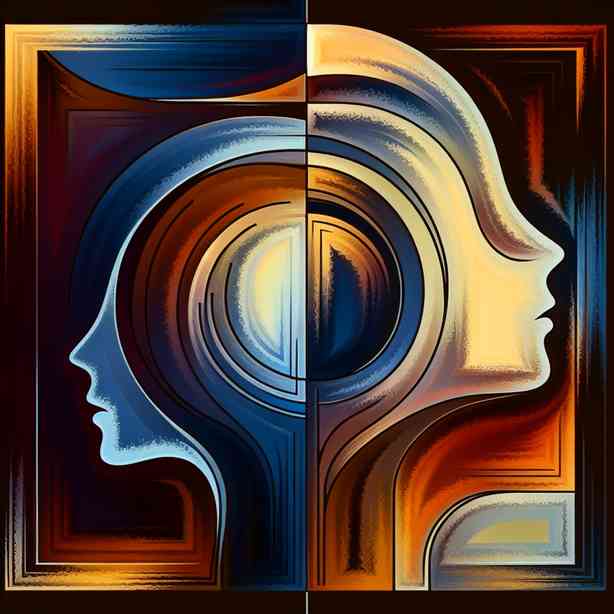
Tension often exists in the spaces we cannot see, rather than in what is overtly present. This idea can be encapsulated in the concept of “negative space.” Negative space refers to the area around and between the subjects of an image or design. It’s the blank space that helps to define the positive space, adding depth and meaning to the whole. In art, photography, and even literature, understanding and utilizing negative space can create a significant impact, enhancing the viewer’s or reader’s experience.
In art, negative space helps to draw attention to the main subjects while simultaneously guiding the viewer’s eye. When an artist intentionally leaves areas of the canvas unfilled, they create a sense of tension and intrigue. This tension arises because the viewer must engage more actively with the piece, considering what is not being shown. For instance, in the famous work of art “The Ambassadors” by Hans Holbein, the distorted skull in the lower portion of the painting serves as a reminder of mortality contrasted with the luxurious life of the two men depicted above. The empty space around the skull enhances its ominous presence, creating a powerful tension between life and death.
In photography, negative space is equally vital. When a photographer composes a shot, they often do so by seeking out spaces that are devoid of distracting elements. This approach allows the subject to stand out, creating a clean and focused image. For example, consider a photograph of a lone tree standing on a hill. The vast sky surrounding it is negative space that emphasizes the tree’s isolated beauty. The tension in this scenario lies in the juxtaposition of the single subject against the expansive emptiness, leading viewers to ponder the story behind that solitary tree.
Literature also harnesses the power of negative space. Writers often leave gaps in their narratives, encouraging readers to fill in the blanks with their imagination. This technique can create emotional tension, as readers may feel a sense of loss or longing for what is not expressed. A classic example is found in the works of Ernest Hemingway, where his “iceberg theory” posits that a mere fraction of a story should be presented on the surface, while the bulk of its meaning lies beneath. This method of storytelling leverages negative space by drawing readers into a deeper engagement with the text, allowing them to explore the unsaid.
The role of tension within negative space can also be observed in music. Composers often use pauses and rests to create a sense of anticipation. When a melody suddenly stops, the silence becomes a space in which tension builds, holding listeners on the edge of their seats. The moment before the next note or chord is played carries significant emotional weight, as it leaves room for individual interpretation and personal resonance.
Exploring the concept of negative space can extend beyond artistic domains and permeate everyday life. In our interactions and relationships, what is left unsaid—be it a pause in conversation or an unacknowledged feeling—can create tension that influences dynamics. For instance, when two people are navigating a delicate subject, the silences may communicate just as much as the words spoken. This negative space in dialogue can prompt deeper understanding, urging individuals to reflect on their feelings and perspectives.
Recognizing tension in negative space can also be a powerful tool for personal development. Understanding that certain feelings arise from what is not openly expressed can lead individuals to confront their emotions and thoughts more openly. This process requires a level of self-awareness and vulnerability, as individuals learn to articulate what lies beneath the surface. In this way, negative space becomes a space for growth, allowing people to develop a more profound understanding of themselves and their relationships with others.
Furthermore, tension in negative space can influence how we perceive our environment. For example, a cluttered room can lead to a sense of overwhelm, while a minimalist space with ample negative space can evoke feelings of calm and clarity. The arrangement of furniture, the choice of décor, and even the colors used can all contribute to the tension created through the principle of negative space. By consciously cultivating negative space in our surroundings, we can enhance our well-being and create a more harmonious living experience.
The importance of negative space also extends to the digital world. In web design, for instance, negative space plays a crucial role in guiding users’ attention and improving usability. A website that employs ample negative space makes it easier for users to focus on content and navigate effectively. Contrasting elements, such as text and images, become more readable when the surrounding space is thoughtfully considered, establishing a connection that enhances the overall user experience.
In summary, the concept of negative space transcends its visual origins to influence various aspects of life, from art and literature to personal relationships and design. The tension that lives in negative space prompts us to engage more deeply with our experiences, encouraging reflection and interpretation. By recognizing and leveraging negative space, whether in our creative endeavors or daily interactions, we can create richer, more meaningful connections with the world around us.
As we delve deeper into the significance of negative space, it becomes clear that it is a vital element in both creative and emotional expression. Recognizing its presence allows us to appreciate the profound impacts of what is not immediately visible. Embracing the tension in these spaces can enrich our understanding of art, literature, and interpersonal dynamics, leading to a more holistic view of our experiences.
Ultimately, the journey through negative space teaches us the value of silence and absence, compelling us to explore what lies beneath the surface of our thoughts and emotions. By cultivating awareness of these hidden depths, we can navigate the complexities of life with greater intention and insight, finding beauty in the very tension that arises from the interplay of presence and absence.


